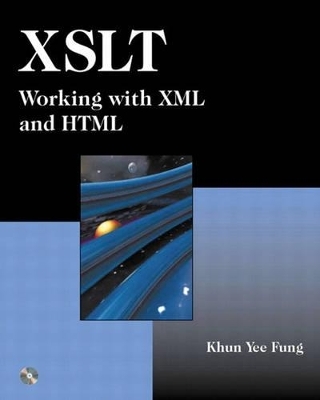
XSLT
Addison Wesley
978-0-201-71103-5 (ISBN)
- Titel ist leider vergriffen;
keine Neuauflage - Artikel merken
XML is fast becoming the standard for structuring documents for web-based information exchange. However, for XML documents to be displayed on a web browser, they must be "transformed" -- into XSL documents on the client side, or HTML documents on the server side. XSLT, recently finalized by the W3C, is a lightweight language designed specifically for this purpose -- but reliable XSLT documentation has been extremely scarce. This is the first practical, comprehensive XSLT tutorial and reference based on the final standards -- which changed significantly from earlier drafts. Understand XSLT's tree-based view of the document; then master the features of XSLT that allow you to transform XML documents from one document type to another; to HTML documents; or to text documents. Review the specifications that are tightly linked with XSLT, including XML namespaces and XPath; then walk through a series of practical examples and a detailed case study demonstrating the creation of a robust XSLT application.
The book includes a detailed reference to XSLT and XPath elements and functions, as well as a CD-ROM containing all code, plus exclusive software enabling the reader to explore XSLT's most challenging feature, expressions. For all Web developers, site administrators, and others working with XML, XSL, or XSLT.
Khun Yee Fung is a senior software architect at ExtendMedia, Inc., an interactive TV and Web site content designer and provider. He has trained HTML developers to become XSLT developers, and was involved in the architecture and design of a Web site publishing system that uses XML and XSLT. 0201711036AB04062001
PART I.
1: Introduction.
What Is XML?
The Importance of Extensive XML Documents.
The Difference between XML and HTML.
Presenting XML Documents.
The Role of XSLT.
XSLT in the HTML Publishing Pipeline.
Summary.
Looking Ahead.
2: XML.
URI.
The Basic XML Document Structure.
Valid Names in XML.
Elements.
Character Data.
Entities.
Processing Instructions.
Comments.
The Root of an XML Document.
Summary.
Looking Ahead.
3: Introduction to XSLT.
The Meeting Room Booking Documents.
Designing XSLT Documents.
Summary.
Looking Ahead.
PART II
4: XML Documents as Trees.
Tree Terminology.
Converting an XML Document to a Tree.
Traversing a Tree.
Document Order.
Distinctness of Nodes in a Tree.
Summary.
Looking Ahead.
5: Paths.
Paths and Expressions.
Location Paths.
Combining Steps.
Data Types and Operations.
Names of Nodes.
Examples of XPath Expressions.
Summary.
Looking Ahead.
6: Transformation.
Visualizing Transformation.
Literal Result Elements.
A Simple Template with an xsl:apply-templates Element.
Nested xsl:apply-templates Elements.
Patterns.
Matching Template.
Template Priority.
Current Node and Current Node List Versus Context Node and Context.
Another Look at XSLT Documents.
Summary.
Looking Ahead.
7: Control.
The xsl:if Element.
The for-each Element.
Looping with Named Templates.
Sorting.
Sending Messages to the Console.
Parameters Outside the XSLT Document.
Summary.
Looking Ahead.
8: Constructing the Result Tree.
The xsl:output Element for HTML.
Including Literal Result Elements.
Constructing Elements.
Inserting Comments.
Inserting Processing Instructions.
The xsl:text Element.
The xsl:value-of Element.
Variables.
Result Tree Fragments.
Whitespace-Only Text Nodes.
Summary.
Looking Ahead.
9: Combining Templates.
The xsl:include Element.
The xsl:import Element.
The xsl:apply-imports Element.
Summary.
Looking Ahead.
10: Extensions.
Declaring Extension Functions and Extension Elements.
Using Extension Functions.
Using Extension Elements.
Checking Availability.
Summary.
Looking Ahead.
PART III
11: Idioms and Tips.
Table Generation.
Character Replacement.
Using xsl:include for Project Reuse.
Using xsl:import for Reuse from Different Projects.
Using the mode Attribute to Organize Templates.
The xsl:include and xsl:import Elements.
Using a Global Parameter to Seed Configuration.
Absolute Paths and Template Patterns.
Steps for Template Patterns.
Using Simple Predicates in Template Patterns.
Using translate()to Convert Cases.
Short Templates.
Identifying Your XML Data.
Using xsl:apply-templates.
One Page at a Time.
Mockup, Generalize, Write.
Working Directory.
Inside-Out XSLT Template Application.
Removing an Element.
Using XML Configuration Files.
Using Lineup Files.
One Subtree at a Time.
Using xsl:copy-of.
Overriding Default Templates.
Avoiding the Descendant Axis.
Reducing the Size of Node-Sets.
Avoiding Multiple Predicates.
Summary.
Looking Ahead.
12: A Case Study.
The Web Site.
Designing the XML Files.
Organizing the XSLT Documents.
Designing the XSLT Templates.
Summary.
Looking Ahead.
PART IV
13: Transforming to XML and Text.
XHTML.
XSL.
SVG.
Transforming an XML Document to Text.
Summary.
Appendix A: Tools and Resources.
XML Tools.
Resources.
XSLT Web Sites and Mailing Lists.
Where to Find the Examples.
Appendix B: Character Sets and Encoding Schemes.
Appendix C: XSLT and XPath Reference.
XSLT Elements.
XSLT and XPath Functions.
Suggested Resources.
Index.
| Erscheint lt. Verlag | 4.1.2001 |
|---|---|
| Verlagsort | Boston |
| Sprache | englisch |
| Maße | 186 x 232 mm |
| Gewicht | 928 g |
| Themenwelt | Mathematik / Informatik ► Informatik ► Programmiersprachen / -werkzeuge |
| Informatik ► Software Entwicklung ► Objektorientierung | |
| Mathematik / Informatik ► Informatik ► Web / Internet | |
| ISBN-10 | 0-201-71103-6 / 0201711036 |
| ISBN-13 | 978-0-201-71103-5 / 9780201711035 |
| Zustand | Neuware |
| Haben Sie eine Frage zum Produkt? |